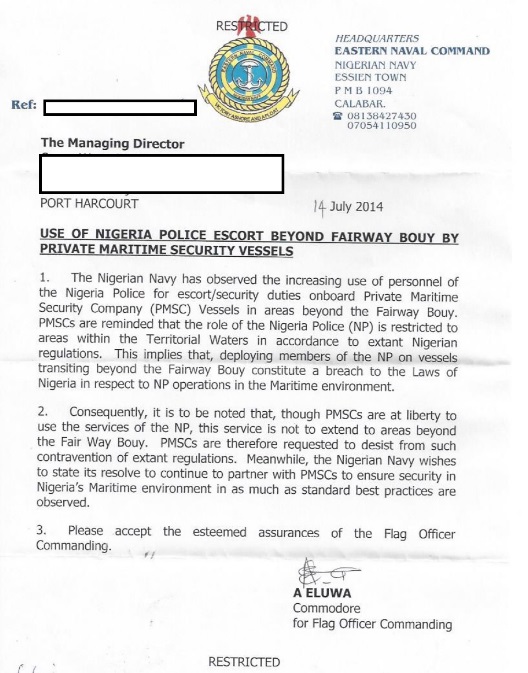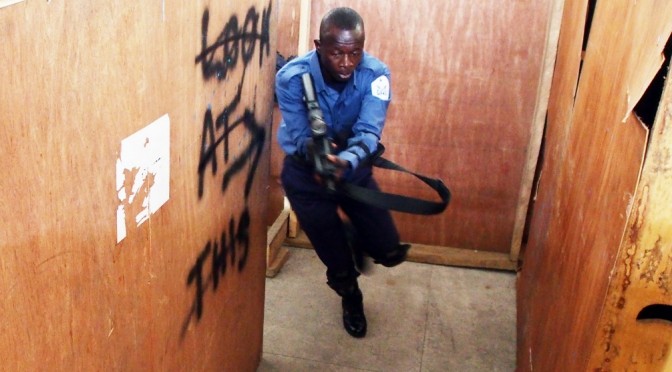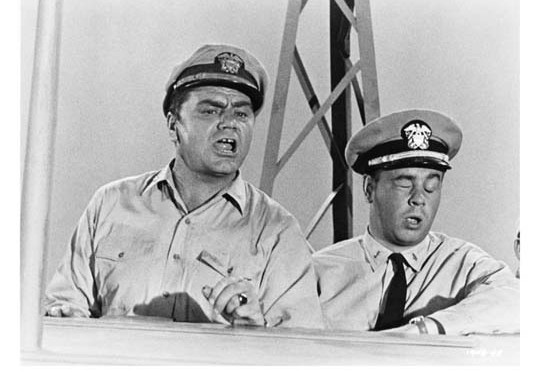My previous article explored the use of police and naval forces in Nigeria for the provision of private maritime security. The analysis focused on the Nigerian Navy’s Western Naval Command’s area of responsibility and visiting merchant vessels, rather than the use of security forces on oil & gas prospects inside the Nigerian Exclusive Economic Zone (EEZ).
This article investigates the effectiveness of various private arrangements with Nigerian security as well as some updates on the “usage” and liability implications for shipping companies utilizing such services.
Status of the use of Nigerian Navy and Police for private maritime security roles
There is no single legislation specifically dedicated to regulating maritime security issues in Nigeria. Rather, the issue of maritime security in Nigeria is dealt with in piecemeal fashion in various legislative instruments, as a result of which there seems to be some degree of overlap of functions between the Nigerian Navy and the Nigerian Marine Police (NMP). What we observe at the moment is the evolution of rules and policies through practice adopted by security agencies within their respective jurisdictions. As I have pointed out in my last article here, there is a discrepancy between the individual arrangements by unauthorised agents and clients and the rules and policies set by the security agencies irrespective of whether those are enforced or not.
Subsequent to my previous article, the Inspector General of the Police (IGP) has reiterated in writing to the Commissioners of Police (Maritime) in the relevant coastal states of Nigeria his policy that his personnel (the NMP) are not to be used outside their jurisdiction. Some agents and security providers have sought to side-step this restriction by alleging they had been granted permission to embark naval personnel. The Nigerian Navy’s position remains that any use of Nigerian Navy personnel without a Memorandum of Understanding (MoU) or in contravention to the terms therein is considered “unofficial allocation” and thus unauthorised. No evidence in writing, except the acknowledgement by various naval commands of receipt of enquiries, have been provided to back claims that the Nigerian Navy has reversed its previous stance that it has adopted since 2012.
![[Photo: “Acknowledgement of receipt” provided by a security provider to a client as “evidence” of approval to embark naval personnel.]](https://cimsec.org/wp-content/uploads/2014/09/security-receipt.jpg)
Embarked security forces are a relatively new development in Nigeria. Traditionally, government security forces (in the Niger Delta) have utilized light craft for escort duties. Embarked teams were largely confined to platforms, which inside the EEZ constitute extensions of sovereign territory. Whether this approach was the result of a deliberate security planning process or not is now hard to establish, but it has had implications on how the navy’s light forces have evolved from their operational and tactical low point in 2006/7 until today and how the Nigerian Navy views its role in securing private assets in Nigerian waters.
Embarked security teams in Nigeria, where they exist, continue to share many attributes of the poorly trained and motivated forces that make up the bulk of Nigeria’s garrison army and land-based security forces. Adding this to the lack of aptitude (in terms of training, familiarization etc.) of those teams for the maritime environment, then it becomes clear that the question whether to use embarked security or escort vessels is more than a legal (or even financial) question; it is about the ability to deliver effective security and mitigate risks without creating (more than is necessary) new ones.
Embarked security teams
The record of embarked security forces on client vessels is in the Gulf of Guinea is mixed. Contrary to the Indian Ocean experience, vessel carrying embarked armed teams off Nigeria have been boarded and seized by attackers or crewmembers kidnapped, although this was most frequently the case in the context of the Niger Delta insurgency between 2006 and 2009 that targeted floating offshore installations, such as the FSO OLOIBIRI, the FPSO MYTRAS or the BERGE OKOLOBA TORU. However, the conditions and modus operandi that embarked teams continue to face in and off the Niger Delta remain similar and many target vessels today are in fact tankers that are stationary, drifting or engaged in ship-to-ship transfers and therefore tactically not more challenging to the attackers (who are for the most part ex-militants). If anything, the small product tankers are easier to board than the high-freeboard Floating Production Storage & Offloading units targeted by the militants during the insurgency.
The vulnerability of embarked security teams is even more pronounced for security vessels, especially those of an improvised nature with no mounted weapons, which are a requirement for those vessels approved by the Nigerian Navy under the current MoU. In the discussion on pirate violence in Nigeria it is often forgotten that almost half of the casualties to date in pirate incidents have been government security forces – usually embarked on vessels of oil & gas contractors. This has prompted the Nigerian inter-agency Joint Task Force in the Niger Delta to declare a ban on using such embarked teams from 19 November 2013 onwards in favour of river gun boats. Companies continue to ignore this at their own risk, as a recent example of an attack on a contractor vessel on the Sambreiro River on 17 June 2014 shows: one soldier and two crewmembers were injured before the attackers managed to snatch an employee of an oil company from the boat.
The embarked security forces’ shortfalls range from inability to detect and engage at night (when the bulk of attacks take place off Nigeria), inability to manoeuvre, and lack of co-ordination to poor weapons discipline. Poor motivation of the embarked soldiers and police officers in the face of aggressive and well-equipped attackers complement the picture. This pattern has not fundamentally changed since 2006/7.
Case Study 1: SP BRUSSELS
The fatality of one crewmember on board the PYXIS DELTA roads during a shoot-out between her embarked security detachment and attackers on Lagos roads the night of 4 February 2013 was brushed off as a tragic accident. The attack on the Marshall Island-flagged product tanker SP BRUSSELS off the Niger Delta on 29 April 2014, however, highlighted the risks associated with embarking armed teams in the Gulf of Guinea, especially off Nigeria. These risks are commonly misunderstood by people who believe that armed teams have the same effect in the region as they have in the Indian Ocean. This is not the case.
The SP BRUSSELS’s chief engineer paid for this misunderstanding with his life; the 3rd officer narrowly escaped when the ship’s bridge suddenly turned into a shooting gallery. While, arguably, the guards prevented the ship from being hijacked, they did so at a price. Given that none of the 38 successful tanker hijackings since the VALLE DI CORDOBA incident in December 2010 in the Gulf of Guinea had resulted in a fatality, this was an avoidable result.
From the confused crew accounts of the attack on the SP BRUSSELS and the Nigerian Navy’s investigation several things become clear:
The vessel was transiting in international waters with two embarked Nigerian policemen (NMP) as security guards. At the time of the attack (ca. 2015 hrs) by a single speedboat and a total of 8 attackers, the ship was idling at 6 kts approximately 35 nm from the Bayelsa coast, SW of Forcados (Delta State), a notoriously dangerous area off the Niger Delta at the time.
- Of the 2-man team, one was on watch, smoking at the time of the attack in the starboard bridge wing (the attack unfolded on the port side, leading to the death of the chief engineer)
- There was no general alert and the second guard had to be roused by a crewmember. By the time he arrived on deck it appeared some attackers had already boarded.
- The guard team appears to have made their stand on the bridge, possibly killing two pirates in the process while the ship’s crew hid in the citadel (with the exception of the injured 3rd officer and the dead chief engineer).
- The actual course of events until the next morning remains controversial, with the Nigerian Navy alleging that their intervention by NNS BENIN and NNS IKOT-ABASI had resulted in the defeat of the pirates and the subsequent arrest of the 6 surviving attackers.
- The chief engineer’s exact circumstances of death are uncertain as is the injury of the 3rd officer, as he fled the bridge.
![[Photo: Damage to the bridge of SP BRUSSELS from the firefight on the bridge. (Source: withheld)]](https://cimsec.org/wp-content/uploads/2014/09/Brussels-damage.jpg)
Case Study 2: SEA STERLING
The Nigerian-flagged product tanker SEA STERLING was attacked on 26 August 2014 west of the Pennington Loading Terminal, 45 nm SSE of the position in which the SP BRUSSELS had been attacked in an area, which to date in 2014 had experienced no less than 3 kidnappings, a hijacking and at least 7 attacks against product tankers – the majority in January-March 2014.
The SEA STERLING carried a team of three Nigerian Navy ratings, procured through a PMSC that had recently set up business in Nigeria and held the same MoU with the Navy like all 42 security companies, which, as mentioned above, only permits the use of navy personnel on “suitable” and “approved” vessels, i.e. patrol boats which are entered into the Nigerian Navy’s list of warships.
![[Photo: The SEA STERLING on Lagos roads in April 2014. (Dirk Steffen)]](https://cimsec.org/wp-content/uploads/2014/09/Sea-Sterline.jpg)
A privately contracted patrol vessel (name withheld) from an adjacent oil field responded to the distress call and arrived on the scene at 2345 hrs, firing several warning shots which prompted the boarders to disembark, return to the bunker barge and flee the scene of the crime. The ship was inspected by the naval craft, but lacking further authority could not prevent from SEA STERLING departing from the area in the early hours of 28 August with her AIS still switched off.
Patrol boats: opportunities and limitations
In a report of Gulf of Guinea tanker hijackings Risk intelligence identified at least 11 cases between December 2010 and August 2013 which involved a local or international naval response with warships, either as part of a patrol scheme or in response to an ongoing attack. This figure does not include incidents where local navies were called and did not respond or react. In six of the seven “prevention cases” the naval forces were successful in disrupting the attack; in one case two Beninese naval vessels were too late to intervene in order to prevent a hijacking. This was in part owed to the ship under attack – the RBD ANEMA E CORE (hijacked on 24 July 2011 off Cotonou) – waiting too long before sending out a distress call.
Once pirates have boarded a ship, the scope for any intervention is much reduced, as the “response cases” show. The unsuccessful sortie of the Togolese Navy in response to the attack on the ENERGY CENTURION on 28 August 2012 off Lomé stands out as an example of local navies’ inability to ensure security of the patrolled zones and to respond effectively at the same time. This argument has been made before, but since that very early stage of the (then very vaguely defined) Togolese secure anchorage, this type of failure has not been repeated.
The inability of local naval forces to provide a timely and effective response is a key argument for those promoting embarked security forces, even though dedicated escort is available both in the Secure Anchorage Area and the Bonny River Convoy. Neither of those two secured operations has so far experienced a successful pirate attack. Patrol boats can also be hired directly, but the cost is a multiple of the embarked team, which serves as a commercial deterrent and is more likely to be the key argument in favour of the embarked security forces.
![[Photo: NNS IKOT-ABASI, pictured here on Lagos roads in April 2014, responded to the distress call made by the SP BRUSSELS. (Dirk Steffen)]](https://cimsec.org/wp-content/uploads/2014/09/IKOT-ABASI.jpg)
Liability
In terms of liability and externalisation of risk, the patrol boats have some advantages over the embarked navy teams. Since even the contracted patrol boats are under navy operational command, law suits for loss of life of navy personnel or damage to navy property will be unlikely, especially inside territorial waters. Conversely, a major European charterer is currently being sued by the Nigerian government over the death of a policeman who was killed while being part of an embarked team.
The possibility of the patrol boat directing its fire against the client vessel (for example to prevent a boarding) is a real risk and probably the gravest. So far, this has not occurred in the Gulf of Guinea. On the other hand, several casualties have occurred as a result of embarked security teams being involved in the defence of merchant vessels. While, it is unclear who actually shot the 3rd officer on the SP BRUSSEL’s bridge, the use of Nigerian Police Force personnel outside their jurisdiction and outside territorial waters had wider-ranging implications for the vessel’s insurance and potentially also opens up the way for a lawsuit by the deceased chief engineer’s relatives against the shipping company.
Many of these liability issues are at the moment only being superficially considered by shipowners and operators especially when arrangements for the provision of embarked security forces are made or implemented in breach of existing legislation or other “policies” promulgated by the security agencies – also referred to as “unofficial allocations” in Nigerian Navy parlance. In this regard, it must be noted that every marine insurance policy has an implied warranty that the voyage is lawful. Thus, having embarked armed guards (or a patrol boat escort as well for that matter) without an express provision in the insurance policy to cover such operations, and that such operations conform to applicable law, may render a lawful voyage potentially unlawful, which in turn may invalidate the policy and discharge the insurer(s) from the liability.
As far as claims by the Nigerian government are concerned, the Nigerian Navy and Police Force may be confronted with a situation in which they will not be indemnified for suffering losses for providing a service inside territorial waters which they would be obliged to render anyway (maritime security) even without pay. However, it is evident that the Nigerian government intends to pursue shipowners or charterers for compensation regardless.
Conclusion
In spite of both local and foreign (even if incorporated in Nigeria) security providers’ attempts to exploit the legal loopholes and lack of inter-agency co-ordination and enforcement of security agencies’ policies, the use of embarked Nigerian security forces in Nigerian waters or offshore Nigeria remains fraught with risks which appear to outweigh the benefits. The use of such teams is frequently an excuse for neglecting other security measures and, understandably, a product of cost and expedience.
The Nigerian Navy remains committed to promoting its own vision of providing localised security through (often privately operated) patrol boats and secured areas and will continue to apply political leverage to that effect, therefore creating a tangible risk for all “unofficial allocations” of government security personnel. As evidenced by the IGP’s directive and the Flag Officer Commanding Central Naval Command’s written approval for the use of NMP inside their jurisdiction on contractors’ security vessels, the Nigerian Police Force’s policy is not as divergent from the Navy’s as it is frequently portrayed.

The current lawsuit over the death of a Nigerian policeman also illustrates that the “official” Nigerian policy takes a dim view of what little regulation exists being undermined by foreign shipping companies and charterers through the use of what are effectively rogue security teams. Whether or not the security agencies’ policies are driven by particular (pecuniary) interests rather than by an overarching security strategy is immaterial with regards to the risks that parties run when ignoring these “official” policies, which are de facto enforced, in favour of “unofficial arrangements”.
Finally, it is becoming increasingly evident that embarked teams – whether contracted directly or through foreign PMSCs – do not provide the level of risk reduction as advertised (or experienced in the Indian Ocean) because they often attract violence by a particular type of Niger Delta-based attackers in a way that embarked security does not in other places of the world.
Dirk Steffen is the Director Maritime Security for Denmark-based Risk Intelligence. He has been covering the Gulf of Guinea as a consultant and analyst since 2004.



 James Bridger interviews Marko Hekkens on the EU project to build partner capacity in Africa and fight piracy-
James Bridger interviews Marko Hekkens on the EU project to build partner capacity in Africa and fight piracy- 

